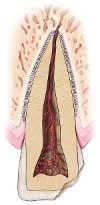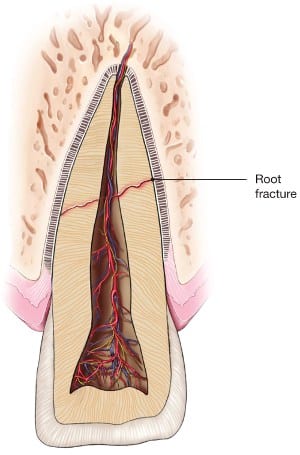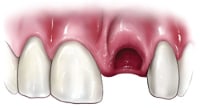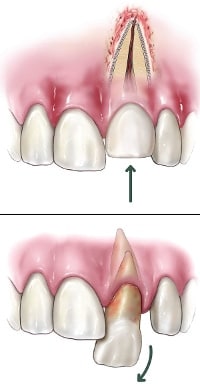
Accidents and Injury
Traumatic dental injuries often occur as a result of an accident or sports injury. The majority of these injuries are minor, chipped teeth. It’s less common to dislodge your tooth or have it knocked completely out and these injuries are more severe. Treatment depends on the type, location and severity of each injury. Regardless of the extent of the injury, your tooth requires immediate examination by a dentist or an endodontist. Sometimes, your neighboring teeth suffer an additional, unnoticed injury that can only be detected by a thorough dental exam.
Endodontists are dentists who specialize in treating traumatic dental injuries. With their advanced skills, techniques and technologies they often can save injured teeth. If you have a cracked or injured tooth, find an endodontist near you right away. Most endodontists offer tremendous flexibility in accommodating emergency cases. You’ll have relief from your pain and likely save your tooth, so act as quickly as possible.

Chipped or fractured teeth
If you’ve chipped or fractured your tooth’s crown, it’s likely it can be repaired either by reattaching the broken piece or by putting a tooth-colored filling in place. If a significant part of your tooth crown is broken off, an artificial crown or “cap” may be needed to restore it.
When the pulp is exposed or damaged after a crown fracture, root canal treatment may be needed. These injuries require special attention. If breathing through your mouth or drinking cold fluids is painful, bite on clean, moist gauze or cloth to help relieve symptoms until you can get to your dentist’s office. Never use topical oral pain medication (such as Anbesol®) or ointments, or place aspirin on the affected areas to eliminate pain symptoms.
Injuries in the back teeth, such as fractured cusps or cracked molars, require root canal treatment and a full coverage crown to restore function to your tooth if the crack extends into the root. More seriously injured split teeth may require extraction.
Watch an informative video about cracked teeth from the AAE here.

Root fracture
A traumatic injury to your tooth may also result in a horizontal root fracture. The location of the fracture determines the long-term health of your tooth. The closer a fracture is to the root tip, the better the chances of success and long-term health; fractures closer to the gum line are more debilitating for your tooth. Sometimes, stabilization with a splint is required while the tooth heals.

Knocked-out (avulsed) tooth
If one of your teeth is completely knocked out of your mouth, see an endodontist or dentist immediately! Time is of the essence and if you receive treatment quickly, preferably within 30 minutes, there is a chance to save your tooth.
Handle a knocked-out tooth very carefully and don’t touch the root surface. Following a few important steps will help increase the likelihood of saving your tooth. Your endodontist or dentist will evaluate the tooth, place it back in its socket and examine you for any other dental and facial injuries. A stabilizing splint might be placed for the next few weeks. Depending on the stage of root development, your dentist or endodontist may start root canal treatment a week or two later.
Review and remember these tooth-saving steps:
1. Pick up the tooth by the crown (the chewing surface) NOT the root.
Locate the tooth immediately; don’t leave it at the site of the accident. Handle the tooth carefully when you pick it up, and never touch the root of the tooth, only the crown (chewing surface).
2. If dirty, gently rinse the tooth with water.
Use only water to gently rinse off any dirt. Do not use soap or chemicals. Don’t scrub or dry the tooth, and don’t wrap the tooth in a tissue or cloth.
3. Reposition the tooth in the socket immediately, if possible.
Try to put the tooth back into its socket right away. Gently push it in with your fingers, by handling the crown, or position it above the socket and close your mouth slowly. Hold the tooth in place with your fingers or by gently biting down on it.
4. Keep the tooth moist at all times.
The tooth must stay moist at all times, either in your mouth or, if it can’t be replaced in the socket, put it in milk, in your mouth next to your cheek, or in an emergency tooth preservation kit (such as Save-a-Tooth®). Don’t use regular tap water; root surface cells can’t tolerate that for extended periods of time.
5. See an endodontist or dentist within 30 minutes of the injury.
Bring the tooth with you to your emergency appointment ideally. It’s best to see the doctor within 30 minutes; however, it is possible to save a tooth even if it has been outside the mouth for an hour or more.

Dislodged (luxated) teeth
During an injury, a tooth may be pushed sideways, out of or into its socket. Your endodontist or general dentist will reposition and stabilize your tooth. Root canal treatment is usually needed for permanent teeth that have been dislodged and should be started several days following the injury. Medication may be put inside your tooth as part of the root canal treatment; once treatment is complete and has been deemed successful a permanent root canal filling or crown will be put in place at a later date.
Children ages 12 and under may not need root canal treatment since their teeth are still developing. New research indicates that stem cells present in the pulps of children can be stimulated to complete root growth and heal the pulp following injuries or infection. When a child’s tooth is injured, an endodontist or dentist will monitor the healing carefully and intervene immediately if any unfavorable changes appear. Multiple follow-up appointments are likely to be needed.

